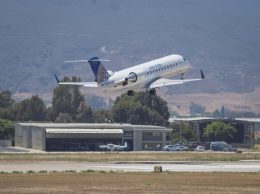United takes a step back in time by adopting outdated system
 Exactly one month ago, United Airlines flipped the switch on a much-publicized systems integration that was supposed to mark a big step forward in its merger with Continental Airlines.
Exactly one month ago, United Airlines flipped the switch on a much-publicized systems integration that was supposed to mark a big step forward in its merger with Continental Airlines.
Aftershocks from the merger continue to reverberate across United and its United Express subsidiary. Operated by SkyWest Airlines, United Express is the only carrier in the region that serves all three commercial airports — Santa Barbara, Santa Maria and San Luis Obispo. United Express flights often provide the most powerful gateway for business travelers to reach domestic and international destinations.
The biggest problem, one that would drive any tech-savvy user crazy, is that United junked an award-winning, state-of-the-art reservation system and adopted the Continental Airlines model based on older technology known as System One. Don’t get me wrong: As a business owner I respect the fact that United saved a ton of money doing it that way.
But going back several generations with a website that’s clunky and not terribly user friendly is asking your customers to do a lot. Flight credits post more slowly. Pricing out flights is not as transparent. Reach somebody on the phone? Forgetaboutit. United has admitted that its reservations lines have been clogged—presumably by scads of people who can’t figure out how to navigate the website —and it said in late March that it would add more phone operators to try to hold down wait times.
As somebody who flies several times a month—mainly going back and forth to my house in Colorado on weekends — I can tell you from first-hand experience that the systems integration has been fairly ugly.
I suspected as much when, a few weeks before the big United-Continental systems merger, I got on the phone to make sure my United and Continental accounts were ready to be synced up. A very helpful reservations agent asked me to remember my Continental pin code. In other words, they were asking me for a number I made up to get access to my account in the 1990s — before the Internet was in common use. Is this any way to run an airline?
In my case, the agent cut me some slack and when I was able to remember enough of my original pin, she said she trusted I was who I said I was and allowed me to create a new one. But here is the rub and the business lesson in the United Systems integration.
For the past few decades, United operated on a rigid set of simple rules — rules that were fully understood by millions of customers, especially those coveted business flyers.
Rule No. 1 was that status mattered most. Rule No. 2 was that the people at the highest status level, 1Ks, got whatever they wanted. Rule No. 3 was that as United forced more interaction with its website, it made pricing more transparent and the interface user friendly. Rule No. 4 was that the pampered status holders got little perks on the web, including a feedback system that got an email response from an actual person.
One big side effect of systems integration is that status levels no longer are clear or transparent and access to fast-track phone lines and emails for feedback has been all but eliminated.
In other words, United has suspended the rules for its business customers, and there’s no sign yet of the old order being replaced with something new. Business travelers are a patient lot — we put up with slightly messy planes, disgruntled crews, lack of clarity in handing out upgrades and, at least for now, old, clunky technology on the Web.
But the bottom line is that over time, the post-integration United will have to show customers that it has a plan to dramatically improve its website. It will also have to create an effective and transparent set of rules for its highest value customers. Or it will put its most important business relationships at risk.
• Contact Editor Henry Dubroff at [email protected].












